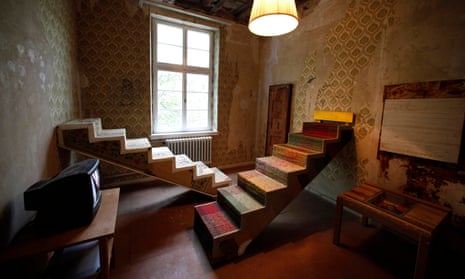It is one of the most ambitious arts events likely to happen this year: the first UK public project by the lauded American artist Theaster Gates, in which the dramatic ruins of a city centre church will host performances around the clock for 24 days.
Visitors to Bristol’s Temple Church might encounter a choir at teatime, performance poetry at 10pm, a drum and pipe band at 8am, popstars at noon or readings in the depths of night. The idea, Gates says, is that there will be continuous sound for 576 hours.
That sound will be produced by a diverse array of Bristol performers. “The hope is that Bristol will hear itself,” Gates said. “It could be a platform for protest, but it could also be a place of deep reflection or celebration or mourning. Sound allows emotion to do really cool things.”
The project, which will launch on 29 October, is called Sanctum. Produced by the arts commissioning group Situations, which was behind the burial of gold on Folkestone beach by the artist Michael Sailstorfer last year, Sanctum is among the events and initiatives marking Bristol’s year as European green capital. Attracting one of the most sought-after artists in the world is something of a coup for Bristol. ArtReview placed Gates 44th in its most recent Power 100, calling him “the poster boy for socially engaged art”. He is best known for his arts and urban renewal projects on the South Side of Chicago, his home city, and this year won the biennial Artes Mundi contemporary art prize, sharing the prize money with other shortlisted artists.
Situations director Claire Doherty travelled to Chicago to persuade Gates face to face. “I actually sat on his front step and waited for him to come back,” she said. “We had a fantastic conversation about what he had achieved in Chicago and where he saw his art practice going. He was getting a lot of invitations to regenerate cities, but what we really connected on is [that] he can’t just parachute in to various locations and do what he has done in Chicago.”
The Bristol project will involve hundreds of performers from all kinds of disciplines, together sustaining a sound or voice for 576 hours continuously. Organisers will announce exactly who is taking part in September, but visitors will not know who is on when. “When you go in, you won’t know who is going to play,” said Doherty. “It levels the performance and means it is very much the city speaking rather than a gig.” There will be opportunities to reserve a place in the audience, which will number around 40-50 people and queues are anticipated at peak times.
A good number of performers have already been recruited and Doherty said the response had been overwhelmingly positive. “Once you start to ask people, they say, ‘Oh, you must try …’ It is creating a network across the city.”
She said the common reaction to a environmental project commission was to explore recycling. “Theaster’s work goes deeper. He asks, ‘What do we value about what we have in our cities? Can we make something from we have here, right now?’ It is a project made for Bristol, with Bristol.”
Gates was captivated by Temple Church, a late medieval building bombed in 1940 leaving just exterior ruins, which are now looked after by English Heritage. “When I visited Bristol and was looking at sites, I was just really moved by the ruins,” he said. “I had no initial idea except that the space, even in its current state, should be activated … there was still something extremely resonant there. Buildings fall down, times change and people’s understanding of the sacred and secular world might be in constant flux … Sound has the capacity to make people feel things.”
The artist transforms buildings and materials that have been deemed worthless into places and things that have worth. In Bristol, he has gathered materials from other derelict sites across the city with which he will build a structure inside the church.
News of the project coincides with the announcement of the first monograph on Gates. Phaidon will publish a book collating all his significant projects including 12 Ballads for the Huguenot House, when he turned a historic house in Kassel into a performance venue.
Gates is much in demand. “The more that I say that I can’t replicate Chicago, it doesn’t mean there is no work to be done,” he said. “It just means that every city has so much of its own personality. I have to first ask myself: is there a way I can get to know the personality of a place through its people and places?
“I have to be careful in my engagements, but with Bristol, I don’t know, there is something about its complicated history, its waters, its sacred sites, its working class, its openness, its scale. Sometimes things can happen in places like Bristol that can’t happen in larger, cosmopolitan cities … great things can happen. I hope we’ll make real magic for the 24 days.”

Comments (…)
Sign in or create your Guardian account to join the discussion